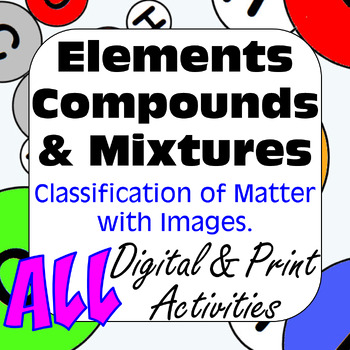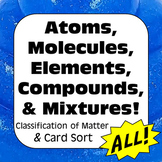Elements Compounds & Mixtures Classification of Matter with Images & Organizer
- Zip
- Easel Activity
What educators are saying
Products in this Bundle (8)
showing 1-5 of 8 products
Bonus
Also included in
- Ready to zoom down to the molecular level and make the world of elements, compounds, and mixtures come alive for your students? Introducing two essential tools that will turn your classroom into a fun and easy exploration of the classification of matter!First, dive into the difference between atomsPrice $12.15Original Price $13.50Save $1.35
- Zoom down to the molecular level to visualize the different between elements, compounds, & mixtures, and organize your notes with handy flowchart style graphic organizers; two essential tools to equip yourself with when starting a journey into the classification of matter.Then, with this firm foPrice $22.05Original Price $24.50Save $2.45
Description
Ready to zoom down to the molecular level and get your hands dirty with elements, compounds, and mixtures? Strap on your lab goggles, because we've got two essential tools to kick-start your journey into the classification of matter!
First up, a Flowchart Style Graphic Organizer will have you visualizing the differences in no time. It's like a secret decoder ring for the molecular realm!
And once you've got the basics down, test your skills with the Interactive Digital Adaptations. These self-checking, digital wonders are perfect for self-directed learning, practice, review, and assessment – ideal for homeschooling, online tutoring, and classroom teachers who need a break from grading.
So, grab your lab coat and let's get molecular! These two tools are the perfect companions for your quest into the classification of matter. Happy exploring!
This bundle includes:
Elements Compounds & Mixtures Classification of Matter Student Note Organizers
- 1-page; sections to organize notes on Matter, Pure Substances, Mixtures, Elements, Compounds, Homogeneous Mixtures, and Heterogeneous Mixtures (landscape, print).
- 2-pages; sections to organize notes on all the above plus: Metals, Non-Metals, Metalloids, Inorganic, Organic, Solutions, Colloids, and Suspensions (portrait, print).
- 1-Easel fillable worksheet (digital).
- 3-pages answers (print).
Elements Compounds & Mixtures Classification of Matter with Images Worksheets
- 3-practice worksheets (print); 24 different images to classify.
- 3-Easel fillable worksheets (digital).
- 6-Easel multiple-choice assessments (digital).⭐Great for summative assessment.⭐
- 3-pages answers (print).
Elements Compounds & Mixtures Classification of Matter with Images Digital Activities #1-3
- 3-Easel interactive activities (digital).⭐Great for formative assessment.⭐
8-slides per activity, each contains an image of particles (atoms & molecules) in matter. Students are tasked with determining how many different particles there are, if the image represents a(n) element, compound, mixture of elements, mixture of compounds, or a mixture of elements & compounds, and if the substance may be classified as a pure substance or not. All photographs & images ©AwesomeScience, for personal use only.
Plus, the following free resources:
- Classification & Separation of Matter Word Search & Puzzle - Free
- Classification of Matter Student Note Organizer (No Answers) - Free
- Elements Compounds and Mixtures Classification of Matter with Images - Free
Additional Classification of Matter Activities may be found here:
- Ultimate Classification of Matter Card Sort & 52-Interactive Digital Activities
- Classification of Matter Atoms Elements Molecules Compounds & Mixtures Bundle
⭐Click here to follow my store and receive the latest updates.
Original Artwork (©AwesomeScience). For Personal Use Only. Uneditable.
Page count does not include Terms of Use and links to supplementary activities.
Copyright ©AwesomeScience 2013 – The Present.
All Rights Reserved by Author.
By using this Resource you agree to the Terms as outlined in the Terms of Service. This Resource is for limited Personal Use only; not to be used, in part or in whole, for commercial purposes. Each Individual License is for use by one specific educator only. Additional licenses must be purchased for each additional educator. Except as permitted in Section 3 to deliver Resources electronically to Permitted Recipients, you may not post or otherwise make the Resource available on any website, application, shared drive or other sites or services.







